A lot has been happening at the CQB and we are excited to share some of the most important news with you in our CQB Newsletter!
A lot has been happening at the CQB and we are excited to share some of the most important news with you in our CQB Newsletter!
10x Genomics and the Center for Quantitative Biology teamed up for a grant program to support an innovative research project at Dartmouth. The winner received a Visium CytAssist slide, library prep and sequencing at no cost.
Optimization of data analysis ecosystems is an important frontier in data analytics science. Access to compute resources with sufficient RAM and technology to analyze genomic datasets is often a rate limiting step to deploying analysis workflows. Furthermore, as datasets become larger and more complex file sizes increase exponentially and storage costs increase in concert with the size of the data. The increased availability of compute resources and the multiple storage tiers available on the cloud has the potential to democratize complex data analytic algorithms that require state of the art technology to run analyses while reducing data storage costs by making use of archival storage for raw files.
The NIGMS has supported the creation of a series of self-guided data science training modules that leverage cloud compute resources to analyze a multitude of data types and analytic procedures. Each module is built around a jupyter notebook interface and will train users to conduct computational analyses of biological data using the Google Cloud Platform. These training materials are accessible through the NIGMS github site, but they will cost money to run using the Google Cloud Platform. The NIGMS and NH-INBRE are providing cloud credits to 10 people per cohort which will provide access to all NIGMS data science training modules for 6 weeks at a time. The dates are as follows:
| Sign up by | Cohort starts | Credits expire | |
| Cohort 2 | August 14 | August 15 | September 29 |
| Cohort 3 | September 29 | September 30 | November 13 |
Here is a list of the training modules available:
To sign up for access to these modules please contact Shannon Soucy (Shannon.Soucy@dartmouth.edu) and indicate the cohort you would be interested in signing up for.
photos: Lars Blackmore
On April 5th, 2023 the Center for Quantitative Biology held its annual meeting at the Hanover Inn in Hanover NH. The meeting is part of an annual review of the COBRE grant by the External Advisory Committee, but also an opportunity for members of the center and the larger community to get together, share their work, and make new acquaintances over breakfast or a glass of wine.
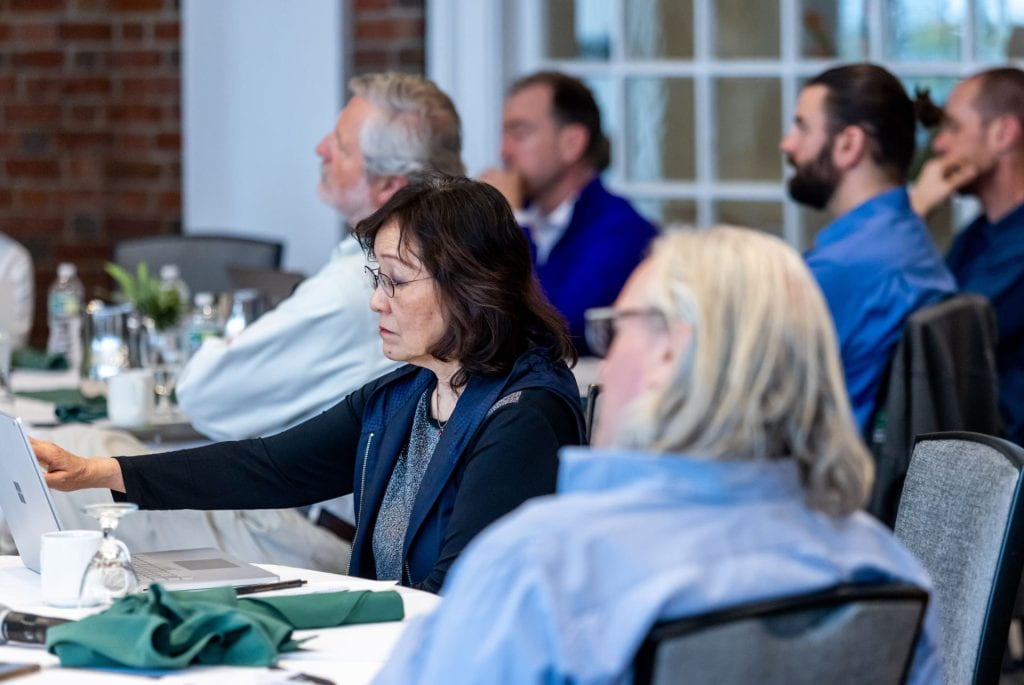

Dr. Whitfield presented a center overview, highlighting the successful graduation of four project leaders, Drs. Matt Mahoney, Feng Fu, Rob Frost and Sladjana Skopelja-Gardner. Drs. Mahoney and Fu rotated off the COBRE in 2022. Also highlighted were our four new research project leads, Drs. Siming Zhao, Britt Goods, Josh Levy and Li Song, recruitment of two new faculty members and ongoing searches in the Department of Biomedical Data Science/Center for Behavioral Health, Department of Molecular and Systems Biology, Thayer School of Engineering and the Department of Microbiology and Immunology.
CQB has had very productive pilot projects with a current application submitted for EAC review. Both Single Cell Genomics and Data Analytics cores have been extremely successful with increasing usage and customer satisfaction. Supplements and grants over the last several years exceed $8 million dollars. SARS-CoV-2 Surveillance project continues to make a significant impact on public health at Dartmouth College and aids in overall public health measures in New Hampshire.

Dr. Skopelja-Gardner presented a nice overview of systemic lupus erythematosus (SLE), explaining how UV light triggers skin disease and exacerbates kidney disease. Her presentation described how ScRNA-seq of enriched glomerular and tubular cells help define cellular subsets and differential expression of renal tissue injury from UV light. She showed which kidney structural cells are injured after skin UV exposure and tissue remodeling pathways activated in glomerular stromal and endothelial cells. Using Deep Neural Network Analysis, courtesy of Dr. Mahoney, the ScRNA-seq data indicates acute glomerular injury even when no histopathology is observed by a pathologist.
Dr. Skopelja-Gardner continued her presentation showing how skin exposure to UV light affects neutrophil interaction with kidney structural cells. She concluded that UV light recruits CD177high neutrophils to the kidney and activates neutrophils across clusters to increase chemotaxis and adhesion. There is ongoing spatial transcriptomic analysis of Lupus Nephritis kidneys to determine if neutrophils mediate flares in SLE patients with concurrent skin inflammation.

Dr. Goods work addresses unmet needs in reproductive health and immunology by applying and developing systems biology tools across biological scales. Her lab aims to solve problems surrounding macrophage fates and functions, non-hormonal contraceptives and identifying drivers of health and disease. Her presentation centered around macrophages and the impact of sex hormones impacting their function. She detailed the experimental approach for generating human inflammatory (M1) and anti-inflammatory (M2) macrophages in culture. After exposure to estrogen, her data showed a pronounced alteration of the global transcriptome for differentiated macrophages, more pronounced in M1. She will continue to focus on understanding the impact of estrogen on differentiation of cells in tissues.
Dr. Goods continued her presentation on the need for novel, female-targeted, non-hormonal contraceptives as part of the Ovarian Contraceptive Discovery Initiative (OCDI). Her experimental design pairs scRNA-seq data and spatial transcriptomics data from mice to provide a comprehensive picture of cells in whole ovaries. Spatial analysis of cells in tissues showed mesenchymal cells distributed across the ovary, several types of luteal cells and clear demarcation of granulosa cell subsets.
Dr. Schultz provided an overview of predicting the evolution of antibiotic resistance. He showed regulation of the E. coli tetracycline resistance tet operon evolves in complex environments and can be lost in fast-changing drug regimens. He presented data on how induction of the wild type mexXYZ multidrug resistance mechanism in P. aeruginosa is slow, but once in the lung it acquires mutations to speed up the response. He also showed how, by understanding the effect of regulatory pathways in the resistance phenotypes of microbes, we can devise treatment regimens that address specific drug-resistance profiles.
Dr. Song presented a brief overview of his proposed CQB project to develop novel methods for microbiome detection and immune repertoire reconstruction from various RNA-seq data. He also discussed his plans for creating databases for the microbiome and immune repertoire in various clinical conditions, leveraging the databases to predict the binding specificities of user provided TCRs and BCRs using statistical modeling. Lastly, he will create open-source packages and web portals to facilitate the TCR/BCR specificity annotation in biological studies.
Dr. Ross provided a brief overview of the gastrointestinal (gut) microbiota and health and the impact of tryptophan metabolites on a host. His pilot project looks at how tryptophan metabolism by human gut bacteria impacts gut microbiome composition and function. He plans to complete initial experiments by the end of May 2023, with a goal of writing an initial manuscript summer 2023.
Dr. Levy presented an overview of colorectal cancer (CRC) and the work he has done to create a low-cost spatial molecular test to infer CRC recurrence risk. He discussed the challenges with lymph node exam and how assessment can hamper recurrence risk assessment. Developing AI technologies which can study the tumor immune microenvironment as a low-cost recurrence risk assessment. His preliminary results provide for possible use of his model in multi-center clinical trials.
Dr. Zhao began her presentation with the central question in human genetics. What are the disease-causing variants and how do they cause disease? She provided an overview of her lab’s work on how germline background affects somatic mutation, what are the functional variants, and which contribute to disease.
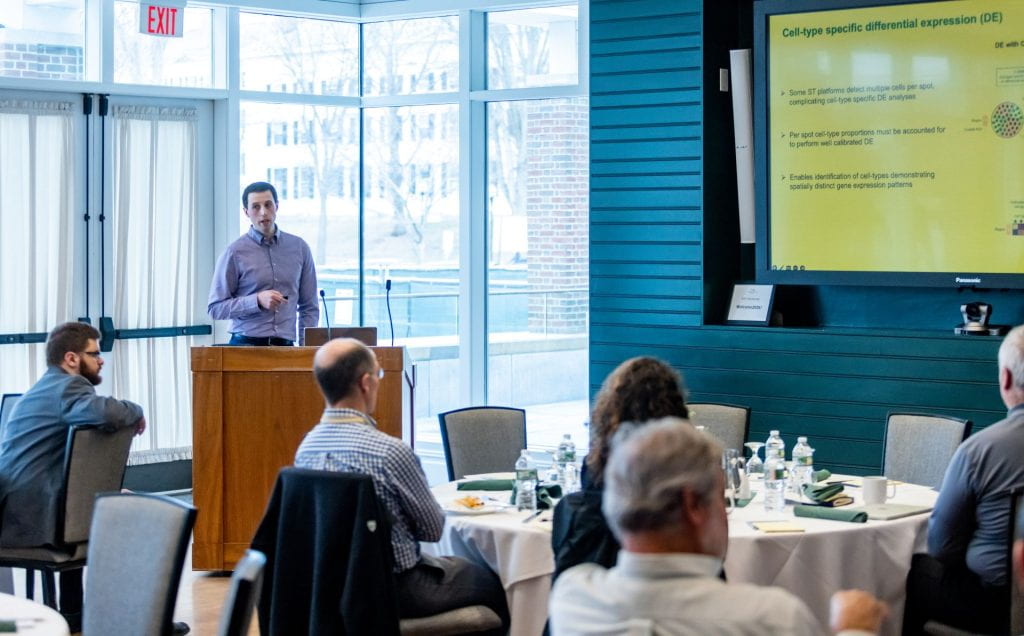
Dr. Owen Wilkins provided an overview of the progress made by the Data Analytics Core over the last year. The core has experienced consistent growth of users and experienced a strong need for additional pipelines and services that focus on spatial transcriptomics and long-read data analysis. Workflows in development include single cell multiome and spatial omics – Visium + MERFISH. Educational developments included 3 annual workshop series, creating NIH training modules on Google Cloud and the build of a single cell analysis workshop.
Dr. Kolling discussed new resources available through the Single Cell Genomics Core, and the ways in which those resources are being used. He discussed some of the challenges the core might face going forward as well as well as new technologies and techniques being developed that the core might consider in the future.
Dr. Joel A. Lefferts and Tim Sullivan presented on the COBRE supplement. Supplement goals are being met for the number of samples sequenced and data is being uploaded to public databases. The group is currently in the process of looking at correlations from sequencing data to ascertain if there are lineages different in NH/VT vs New England, Northeast, US. They are also analyzing the data for correlations of multiple collections from the same patients. They hope to discover helpful information on post-acute COVID syndrome (long COVID) and the correlation of lineage vs age, sex, region, symptomatic vs asymptomatic, source (clinical testing vs campus screening).
The evening ended with a poster session and reception where attendees could learn more about student projects and chat over drinks and hors d’oeuvres.
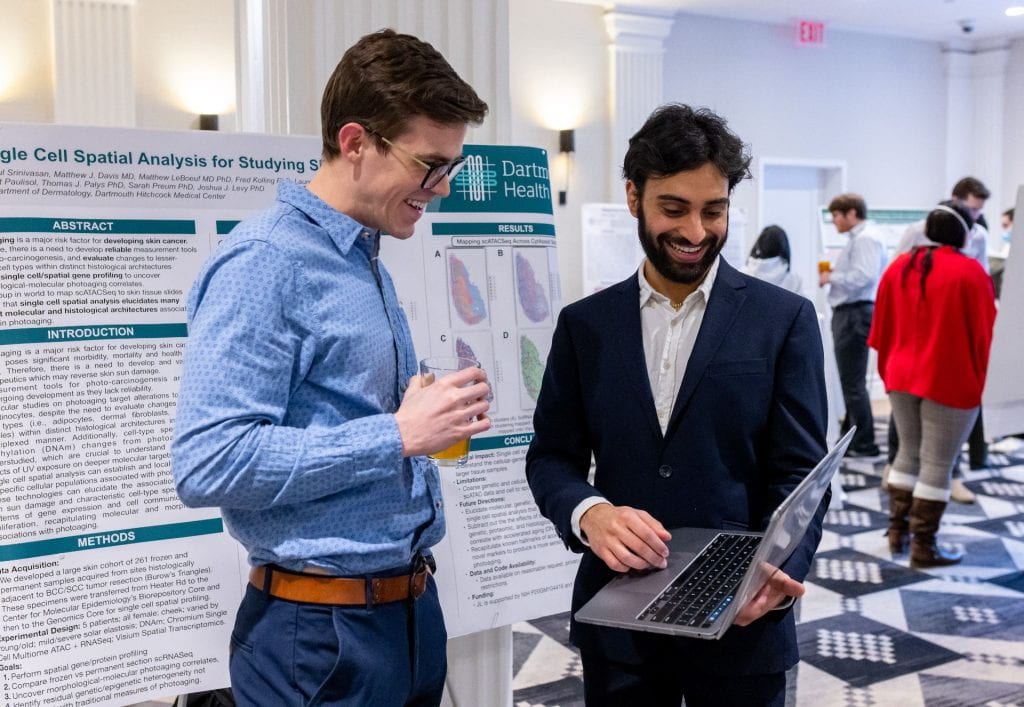

In November, attendees of the Single Cell and Spatial Genomics Symposium began arriving at Auditorium G, DHMC, around 8:30am to grab some breakfast and caffeine before settling into their seats to learn about Single Cell Genomics and Spatial Genomics technologies.

The symposium kicked off with a welcome by Fred Kolling, Director Single Cell Genomics Core (SCG), who talked briefly about the breadth of single cell and spatial genomics services available at Dartmouth, and gave context for the rest of the speakers who would be describing specific new technologies currently, or very soon to be, available through the SCG, and exploring how these technologies have been applied in research.

The first speaker was Caroline Peterson, Science and Technology Advisor for 10x Genomics, who talked about fixed RNA profiling on the 10x Genomics platform. According to the 10X Genomics website fixed RNA profiling “enables the comprehensive profiling of the transcriptome (human or mouse) from single cells using a probe-based approach. The addition of Feature Barcode technology enables simultaneous profiling of cell surface protein expression for multidimensional insights into complex biology. This assay also enables sample multiplexing to increase your throughput and workflow efficiency.” Caroline detailed the capabilities of this technology, how it worked, and how it could be used, and finished by answering questions from the audience.

Next up was another speaker from 10X Genomics, Jeff Bylund, talking about using 10x Genomics Visium technology for spatial transcriptomics. Jeff introduced the concept of spatial transcriptomics and the ability of Visium technology to show whole transcriptome information within the spatial context of a tissue sample. His presentation was full of fascinating visuals of tissue samples side by side with their transcriptome visualizations and examples of how spatial transcriptomics is being used to gain new insights into how cells interact in context and to identify potentially interesting coding sequences and proteins. He also talked about the Visium CytAssist, a new purchase for SCG, which simplifies the Visium workflow for creating Visium slides, allowing users to begin with a standard glass slide, rather than requiring fresh tissue.

After a short coffee break, Alyssa Nolan from Vizgen gave a presentation on using Vizgen technology to run spatial transcriptomics at nanometer resolution. Like the Visium technology, Vizgen allows researchers to run spatial analysis on samples, however with Vizgen technology users select specific genetic sequences to target (rather than studying the whole transcriptome) and are given a much more detailed, higher resolution, result.

The Symposium wrapped up after lunch with a keynote address from Elise Courtois of Jackson Labs Genomic Medicine who spoke about using single cell and spatial genomics technologies to study endometriosis. Endometriosis is a very common, but under-studied condition in which cells similar to those in the uterine lining grow outside of the uterus. We know very little about why this condition occurs in some women and not in others, so any insight into the mechanisms at work could be extremely valuable. Elise’s work has already helped her identify some potential targets for further study.
CQB Director, Mike Whitfield, recently announced changes to the leadership of the Data Analytics Core:
It is my great pleasure to announce that Shannon Soucy and Owen Wilson have been appointed as Co-Directors of the CQB Data Analytics Core. James O’Malley will remain a Faculty Advisor and CQB will be welcoming Rob Frost as an additional Faculty Advisor. Everyone in DAC deserves a huge thank you and even bigger congratulations on making the core what it is today, some of which is highlighted below.
The appointment of Owen and Shannon as Co-Directors aligns with their substantial administrative effort which have played a major role in the success of the core.
Please take a moment when you see them to congratulate both on this fantastic achievement.
– Mike

Project PI H. Robert Frost graduated from the CQB COBRE in September of 2022 after receiving an R35 MIRA award (R35GM146586, Gene set analysis of single cell genomics). Dr. Frost credits the CQB with providing the critical funding, mentorship and core services needed to advance his independent research and support collaborative projects with other Dartmouth faculty. During his three years with the CQB, his group developed a number of computational methods for the analysis of single cell genomic data and leveraged these methods to analyze single cell data generated in collaboration with Dartmouth immunology researchers and members of the CQB Single Cell and Data Analytics Cores. The protected research time enabled by his COBRE project, along with guidance from his mentors, feedback from the larger CQB group and fantastic core facilities, were instrumental to his success.

We are happy to welcome Dr. Benjamin Ross to the CQB as one of our pilot investigators. His pilot project “Revealing the impact of tryptophan metabolism on host-microbe and microbe-microbe interactions in the gut” will help reveal how metabolism of tryptophan impacts microbe-microbe and host-microbe interactions.

Congratulations to Dr. Sladjana Skopelja-Gardner who became a full investigator with the CQB after the success of her Pilot Project “Mechanisms of kidney inflammation and injury in lupus photosensitivity“. She continues her important research with her new project “Neutrophil-mediated pathways of kidney injury in lupus nephritis“.

Project PI Feng Fu was promoted to associate professor with tenure in July 2021, graduating off the COBRE in June 2022. As a COBRE project lead, Dr. Fu worked on mathematical and computational models for understanding efficacies of immune checkpoint inhibitors and their potential combinations in the past three years. Dr. Fu said, “I am very grateful for the COBRE support which brings momentum in my career development at Dartmouth. It helps consolidate my research program in biomedical research and also synergistically interacts with my teaching and research mentoring activities.” In the future, he will continue the work along with interactions and collaborations within the CQB community.

Project PI Matt Mahoney graduated off the CQB COBRE February 2022, after receiving an R01 grant for his project, “Integrating high-throughput histology with systems genetics through causal graphical models.” Dr. Mahoney credits the CQB with providing the essential support needed to build his team and carry out his research. During his three years with the CQB, his group developed computational tools to integrate genetic, transcriptomic, proteomic, and histopathology data, with a goal of resolving the complex chains of causality from a gene variant through molecular networks to tissue structure and, ultimately, clinical outcomes. The guidance from COBRE mentors was instrumental to his success.
Author: Tammara Wood
Photography: Lars Blackmore, www.ameridane.org

The Center for Quantitative Biology and members of its External Advisory Committee (EAC) gathered Wednesday, April 6th at the Hanover Inn to review the progress of the CQB COBRE grant and share research updates. Attendees included CQB investigators, mentors, leadership, and staff, as well as members of the EAC.
CQB Director, Dr. Mike Whitfield, opened the event with a Center overview, highlighting the successful graduation of two project leaders, Drs. Matt Mahoney and Feng Fu, and the addition of two new research project leads, Drs. Siming Zhao and Britt Goods, as well as the active COBRE faculty search ongoing in the Department of Biomedical Data Science. The CQB also contributed to a faculty recruitment in Molecular & Systems Biology. Dr. Whitfield then turned the floor over to a series of CQB Project Leaders to present their ongoing research.
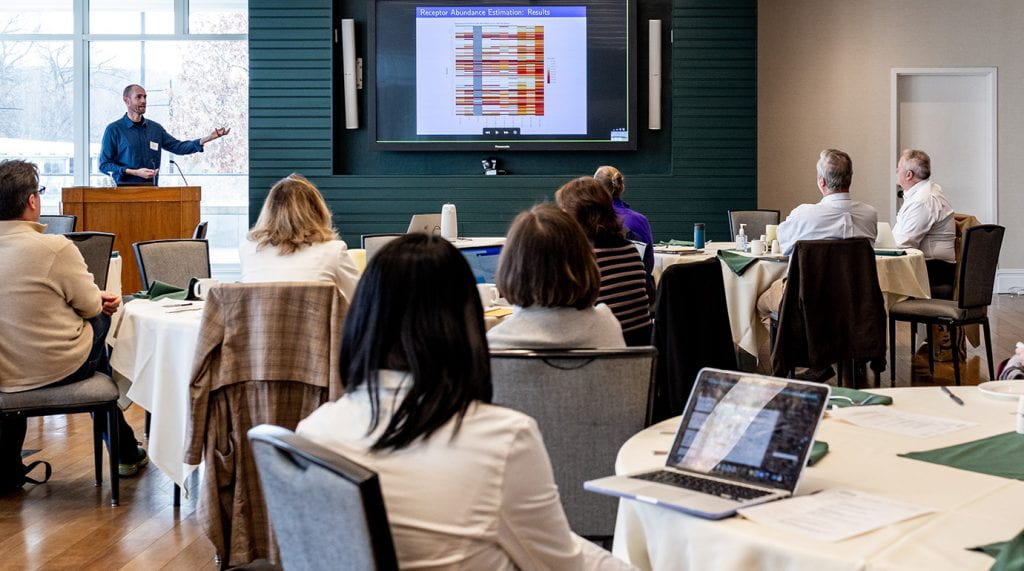
Dr. Frost presented an overview of single cell genomic profiling. He provided solutions and rationale to addressing limitations to this type of data which segued nicely into the progress made on Aim 1 and 2 of his CQB research project. His presentation described several student led projects that grew from these Aims; Multi-label cell typing based on empirical data and expert knowledge, accurate estimation of protein abundance for receptors with or without antibody data, and a method for single sample scoring of taxonomic sets using microbiome relative abundance data.
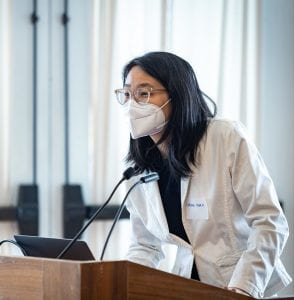
Dr. Siming Zhao, who joined the CQB in July 2021, provided an overview of her project focusing on estimating selection pressure by finding the deviation of mutation rate compared to the background rate, before opening the floor up to questions and suggestions from the audience.
Dr. Schultz provided an overview of predicting the evolution of antibiotic resistance. He showed regulation of the E. coli tetracycline resistance tet operon evolves in complex environments and can be lost in fast-changing drug regimens. He presented data on how induction of the wild type mexXYZ multidrug resistance mechanism in P. aeruginosa is slow, but once in the lung it acquires mutations to speed up the response. He also showed how, by understanding the effect of regulatory pathways in the resistance phenotypes of microbes, we can devise treatment regimens that address specific drug-resistance profiles.

Dr. Mahoney presented on his recently funded R01 project, graduating him from the COBRE. The work involves deep learning segmentation and quantification of kidney tissue. This work uses neural networks to compute “black box” numerical signatures of the variability of kidney tissue across genetically diverse mice. Using these numerical signatures, GWAS is performed to identify genetic loci driving structural variation in tissue and image montages are used to interpret these “black box” features. Next for Dr. Mahoney is ordering CRISPR strains to validate these associations, extending this approach to other tissues, and extending these techniques to include transcriptomic, proteomic, and physiological data.
Dr. Fu’s research plan focuses on a very important issue in the development of combination immunotherapy. He provided an overview of his project which included biomedical data-driven modeling. He will be wrapping up this COBRE project by the end of June and will rotate off July 1, 2022.
All three pilot projects provided an overview of their currently funded projects.

Dr. Patricia Pioli discussed pandemic-related limitations on her ability to acquire necessary materials for her originally proposed studies. As a result, her project pivoted in a new direction. These studies, which focus on inhibiting the development of acquired therapeutic resistance to melanoma inhibitors, were presented in Overcoming Immune Suppression in the Melanoma Tumor Microenvironment (TME). Using a synthetic compound (CDDO-Me), she has shown that resistance is impeded through remodeling of immune activation in the melanoma TME. Her current goals are to elucidate the molecular mechanism by which CDDO-Me alters myeloid activation based on pathway analysis of scRNA-seq data. Future studies will investigate therapeutic efficacy of combination with immune checkpoint inhibitors.
Dr. Diwakar R. Pattabiraman presented his work on understanding the heterogeneity of responses to chemotherapy. He showed the use of DNA Barcodes to map cellular systems and to understand cellular dynamics in response to chemotherapy. From this he has uncovered a specific trajectory that cells take upon treatment with eribulin to undergo mesenchymal-to-epithelial transition. His current goals are to continue this work in vivo.
Dr. Sladjana Skopelja-Gardner’s project, Mechanisms of kidney inflammation and Injury in Lupus Photosensitivity, has the overall goal of identifying targetable pathways that specifically address how sensitivity to ultraviolet sunlight rays, a feature common to most lupus patients, leads to kidney disease (lupus nephritis, LN). She provided defined outcomes and the positive impact this research delivers.
Dr. Owen Wilkins provided an overview of the progress made by the Data Analytics Core over the last year. This included expansion of user base, analysis services, & pipelines, the purchase of a dedicated compute node on Discovery Cluster, multiple authorships on published or submitted manuscripts, increase in requests for letters of support (14 provided over ’21/ ’22) & FTE Analysis for NIH Sars-CoV-2 supplement, partial FTE funding secured as key grant personnel, several ongoing expansion efforts (e.g., Nanopore sequencing), and education & workshop opportunities.

Dr. Fred Kolling presented an overview on the Single Cell Genomics Core, which provides end-to-end single cell services. They have brought on numerous applications to enhance user experience and to expand access to single cell for clinical, translational, and epidemiological research. He discussed the various automated systems evaluated to standardize tissue processing and cell/nuclei cleanup. Key workflow steps were shown for spatial transcriptomics and the instrument supplement that was submitted to acquire the Vizgen MERSCOPE platform which will allow for single-molecule imagining, up to 500 genes per slide, requires no sequencing and is cheaper than current applications.

Dr. Joel A. Lefferts presented on the COBRE supplement. Significant progress has been made in helping to understand the biology of the virus by identifying variants and/or mutations. An AIM of the supplemental grant is to genome sequence ~5,000 samples. Quantitative PCR is used to ensure quality sequencing data. A total of ~3400 positive samples have been sequenced as of 4/6/2022 with many more available. The group is working to prioritize which samples to sequence, such as current cases, next wave, earlier and serial positive cases. A grant to cover year 2 of the project was submitted in March. The goals are to continue to monitor the spread, pathogenicity, and evolution of SARS-CoV-2 variants.



After a series of meetings with the Single Cell Genomics Core, Data Analytics Core, and our Junior Investigators, the External Advisory Committee members; Dr. Kelley Thomas, University of New Hampshire, Dr. Cathy Wu, University of Delaware, and Dr. Paul Robson, Jackson Laboratory, brought the day to a close by sharing their overall program evaluation with CQB leadership and discussing plans for the future.
CQB PI, Dr. Britt Goods, was recently featured in a Tech Explorist article about a study on how milk-producing cells change over time in nursing mothers.
“It gives us a way not only to understand lactation, but it also gives us a set of data and tools to be able to engineer better solutions to improve the quality of life of mothers, specifically when they’re nursing”
-Dr. Britt Goods in the Tech Explorist article “Dynamics of Human Milk Production”
Read the article here: https://www.techexplorist.com/dynamics-human-milk-production/46256/